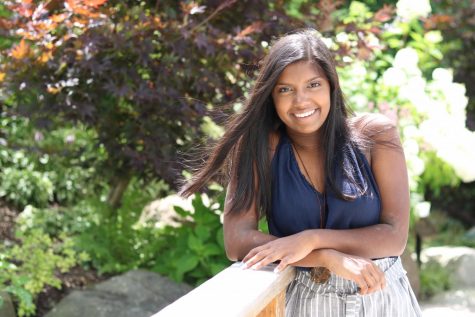Biology students enhance classroom learning with a trip to John Ball Zoo
Within downtown Grand Rapids’s John Ball Zoo lies one exhibit occupied by a rocky pond and surrounded by dispersed patches of sand and shrubbery. Spotted around the exhibit are several tiny, dormant, alligator-resembling reptiles laying motionless. The lone Dwarf Caiman exhibit may not be the most popular or animated, but above it all, fascinatedly observing, stands senior Vincent Pellizzon.
As a part of his AP Biology field trip on a bright September day, Vincent spent over an hour simply observing the Dwarf Caimans. While they remained practically inanimate, his dedicated observations allowed him to design and create an additional feature to add to and improve the caiman’s exhibit.
“They had a nice habitat,” Vincent said. “I guess how little the caimans actually moved surprised me; they were in the same spot all day. The reason I even thought of the enrichment was because the ceiling wasn’t solid, allowing for the enrichment to easily be added or removed.”
Before visiting the zoo, Vincent and his classmates each chose an animal and extensively researched its natural adaptations, features, and behaviors.
Assisted by AP Biology teacher Patti Richardson, students arrived at the zoo with a comprehensive understanding of their animals. The day-long field trip gave students a physical look at the individual behaviors they so intensely focused on in class.
“I think it gives kids a way to see animals behaving naturally, even though they’re not in the wild, and to see the zoo from a different lens,” Richardson said. “By doing the research ahead of time, coming into the zoo, and knowing what you’re looking for, it [emphasizes] how animals naturally behave.”
In its third year, the trip continues to reach the biology staff’s goal of providing students with a real-life, in-depth look at the textbook material they study in class. The first summer before the program commenced, members of the science department met with staff from the zoo and the Grand Rapids Public Museum to orchestrate the process. Since then, each year has been even more rewarding than the next.
This year, science teacher Joslyn Burnaby brought several blocks of her freshman biology students on the trip as well. Though they are just being introduced to concepts surrounding animal species and adaptations, each was assigned an animal to create a new habitat, information placard, and interactive activity for.
“I like the way we learn compared to how we did as middle schoolers,” freshman biology student Tananya Prankprakma said. “The labs really helped me work through what we’re learning and see it in action. Since we’re going through it step by step, I can pinpoint exactly what I don’t understand.”
While given slightly different tasks, freshmen and AP students alike were engrossed with what they were assigned. Between enrichment design, habitat replacement, and dozens of activities scattered around the park, the whole zoo was buzzing with interested and excited student biologists.
“I was most pleased with how engaged everybody was,” Richardson said. “This year, we finally got our assignments to the right lengths, so kids could enjoy the zoo but were also engaged in the zoo.”
Upon return to the school, Richardson noticed that students were more in focus with their learning. For the most part, students began to ask provoking questions or make keen, detailed observations as a result of intently studying their animal at the zoo.
Additionally, Richardson found her students captivated by the pure nature of the zoo, its exhibits, and the conditions the animals resided within. The whole purpose of zoos was broadened for students.
“We often think of zoos as just a place to hold animals versus a place for the conservation of animals and the learning about animals,” Richardson said. “I think it helps for kids to look at zoos with a different lens, versus just for entertainment.”
As projects are wrapped up and designs are submitted to John Ball Zoo, there’s a chance that student designs could possibly be used in future development of animal enclosures. Regardless, this one sunny September day provided biology students with ample real-life implications of the natural world.
“It’s definitely a hope of mine that the zoo gets more funding and is able to improve upon their exhibit,” Tananya said. “As budget wasn’t a restriction on our designs, [our] designs are more idealistic. My realistic hopes are that they enjoyed seeing our designs and think about them while getting better ideas from more educated people who could make the best use of their resources.”

Nisha Rajakrishna is a senior and entering her last year on staff as an Editor-in-Chief. Nisha loves to travel and experience new cultures, and in her...



























































































